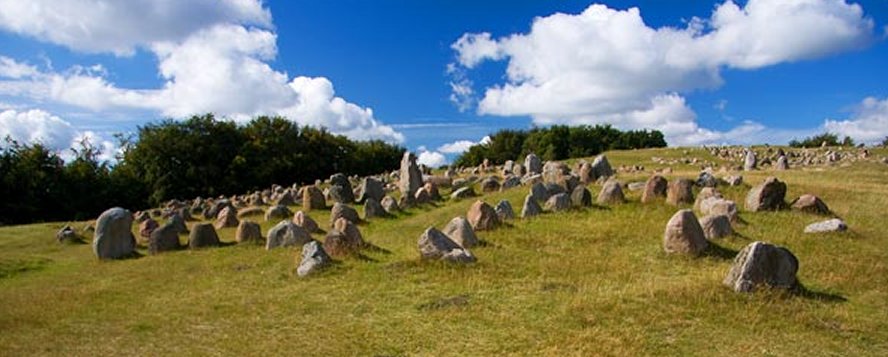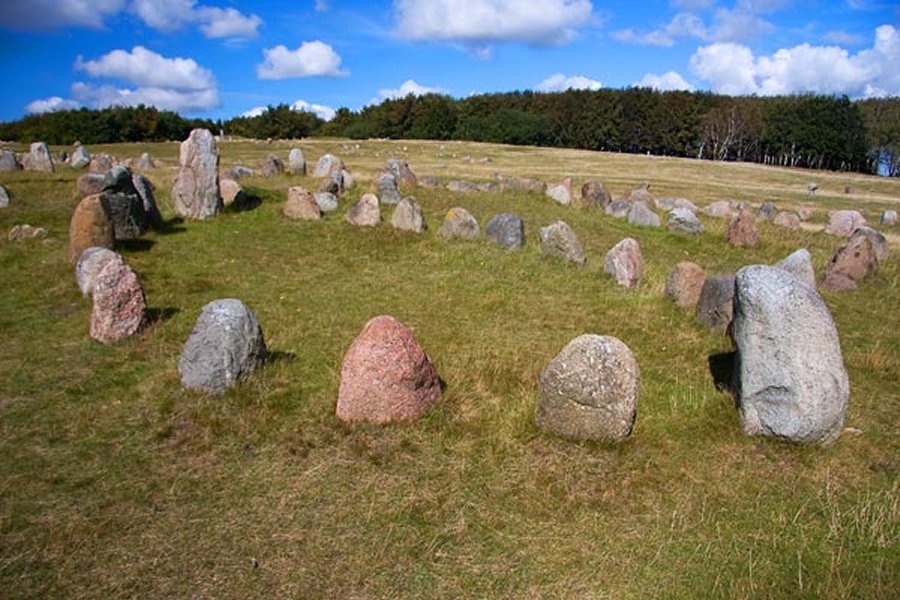Lindholm Høje Burial Site With 700 Graves Dated To The Iron And Viking Ages
A. Sutherland - AncientPages.com - Lindholm Høje is an Iron Age and Viking Age burial site just North of Aalborg and Nørresundby on the South slope of Voerbjerg Hill facing Limfjorden, Denmark.
Lindholm Høje was in use as a burial site between 400 AD and 1000 AD and was excavated from the sand covering the burial site in 1952-1958 to reveal the 700 graves.
The graves are arranged chronologically - the oldest graves from the Iron Age around 400 AD are near the top of the hill.
In those ancient times, the dead were buried on a location with a view - their ancestors were given something beautiful to enjoy from their graves. This Southern hillside sloping down towards Limfjorden is no exception.
The oldest graves from the Iron Age around 400 AD are near the top of the hill, and the further down the younger the graves till the youngest ones from around 1000 AD furthest down. Ity means that the graves were arranged chronologically.
Some of the Viking age graves in Lindholm Hoeje in Nørresundby.
The graves are shaped differently depending on whether it contains a man or a woman. The graves containing men are shaped pointy like viking ships or as a triangle, while women's graves are round or oval.
Depending on the burial customs of the time of each burial, the Iron Age grave was covered with a mound, and the Viking Age grave was a cremation grave with a stone surrounded perimeter, inside which the deceased was cremated.
Graves of men are shaped pointy like Viking ships or as a triangle, while women's graves are round or oval.
This is a typical man's ship shaped cremation grave, where a man was put on top of a fire within the stone circumference and cremated. It was thought that cremation set free the spirit of the man from his body - the cremation started his voyage to join the gods. People were buried with effects that was thought to be put to good use in the spirit world, and the fire didn't help conserve them too well till today, but the oriental coins and accessories excavated show that the vikings had widespread trade connections.
See also:
Vikings: Facts And History About The Tough Norse Seafaring People
Why Did Vikings Burn And Bury Their Longhouses?
Viking Burial Rituals: High Ancient Funeral Pyre Reflected High Social Status
Throughout the time Lindholm Høje was in use, a village was located close to the burial site. The concrete outline shows the outline of a hut which was built next to the graves. The sand that constantly blew in over and covered different parts of the hillside also forced the village, which was probably called Vendel, to move around in the area to avoid it.
Excavations show that the village has been moved from top of the hill to the bottom of the hill, and up North of the hill entirely in the period between 700 AD and 1100 AD.
The Lindholm Høje museum Northwest of the burial site was built and given to the City of Aalborg presents information about the burial site related to the Iron and Viking Ages.
Written by A. Sutherland - AncientPages.com Staff Writer
Copyright © AncientPages.com All rights reserved. This material may not be published, broadcast, rewritten or redistributed in whole or part without the express written permission of AncientPages.com
More From Ancient Pages
-
 Hundreds of Monumental ‘Kites’ Spotted in Arabian Desert
Archaeology | Sep 12, 2022
Hundreds of Monumental ‘Kites’ Spotted in Arabian Desert
Archaeology | Sep 12, 2022 -
 Soft Tissue From A 183 Million-Year-Old Jurassic Plesiosaur – Analysed
Fossils | Feb 24, 2025
Soft Tissue From A 183 Million-Year-Old Jurassic Plesiosaur – Analysed
Fossils | Feb 24, 2025 -
 Valhalla – The Hall Of The Fallen Where Viking Hero Warriors ‘Einherjar’ Dwell After Death
Featured Stories | Mar 11, 2018
Valhalla – The Hall Of The Fallen Where Viking Hero Warriors ‘Einherjar’ Dwell After Death
Featured Stories | Mar 11, 2018 -
 Spectacular Fengdu Ghost City Devoted To Afterlife
Chinese Mythology | Aug 22, 2016
Spectacular Fengdu Ghost City Devoted To Afterlife
Chinese Mythology | Aug 22, 2016 -
 Clues What Tiggered Climate Change 8,000 Years Ago Found In Scotland
News | Sep 15, 2023
Clues What Tiggered Climate Change 8,000 Years Ago Found In Scotland
News | Sep 15, 2023 -
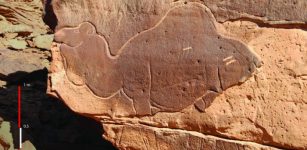 Huge Ancient Animal Sculptures Made By Unknown Carvers At Camel Site In Saudi Arabia Puzzle Archaeologists
Archaeology | Feb 14, 2018
Huge Ancient Animal Sculptures Made By Unknown Carvers At Camel Site In Saudi Arabia Puzzle Archaeologists
Archaeology | Feb 14, 2018 -
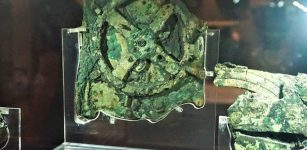 2,000-Year-Old Antikythera Mechanism May Not Be What We Previously Thought
Archaeology | Apr 22, 2025
2,000-Year-Old Antikythera Mechanism May Not Be What We Previously Thought
Archaeology | Apr 22, 2025 -
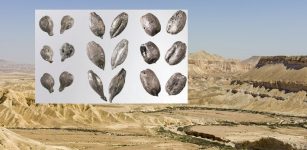 When And Why Negev Highlands’ Agricultural Settlement Was Abandoned? – Researchers Have Answers
Archaeology | Jul 28, 2020
When And Why Negev Highlands’ Agricultural Settlement Was Abandoned? – Researchers Have Answers
Archaeology | Jul 28, 2020 -
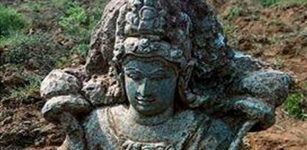 10th Century Sculpture Of Sun God Surya Accidentally Found In Farmland In Andhra Pradesh
Archaeology | Nov 16, 2020
10th Century Sculpture Of Sun God Surya Accidentally Found In Farmland In Andhra Pradesh
Archaeology | Nov 16, 2020 -
 Puzzling Ancient Artifacts Found In Canadian Mountains Defy Explanation – Scientists Say
Featured Stories | Aug 27, 2024
Puzzling Ancient Artifacts Found In Canadian Mountains Defy Explanation – Scientists Say
Featured Stories | Aug 27, 2024 -
 Three Unusual Celestial Journeys And The Chosen Ones Initiated Into The Secrets Of The Gods
Ancient Mysteries | Jul 26, 2021
Three Unusual Celestial Journeys And The Chosen Ones Initiated Into The Secrets Of The Gods
Ancient Mysteries | Jul 26, 2021 -
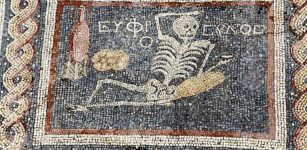 ‘Skeleton Mosaic’ – 2,400-Year-Old Scenes Depicted On Glass Artwork Found In Turkey
Archaeology | Apr 23, 2016
‘Skeleton Mosaic’ – 2,400-Year-Old Scenes Depicted On Glass Artwork Found In Turkey
Archaeology | Apr 23, 2016 -
 When And Why Did Humans Start Using Tombstones?
Archaeology | Aug 29, 2022
When And Why Did Humans Start Using Tombstones?
Archaeology | Aug 29, 2022 -
 Could Neanderthals Meditate? Scientists Investigate
Archaeology | Jun 30, 2022
Could Neanderthals Meditate? Scientists Investigate
Archaeology | Jun 30, 2022 -
 Abu Dhabi Fossil Dunes May Have Inspired The Ancient Great Flood Story – Professor Says
Archaeology | Jul 10, 2022
Abu Dhabi Fossil Dunes May Have Inspired The Ancient Great Flood Story – Professor Says
Archaeology | Jul 10, 2022 -
 Medieval Music Wasn’t Only Supposed To Be Beautiful To Listen To – A New Study Suggests
Archaeology | Jun 8, 2023
Medieval Music Wasn’t Only Supposed To Be Beautiful To Listen To – A New Study Suggests
Archaeology | Jun 8, 2023 -
 Gunung Padang – Remarkable Megalithic Site In Indonesia
Civilizations | Jun 14, 2014
Gunung Padang – Remarkable Megalithic Site In Indonesia
Civilizations | Jun 14, 2014 -
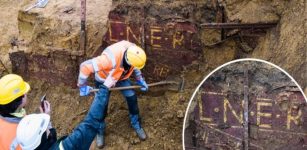 Mysterious Railway Car Discovered Under An Old Fortress In Antwerp, Belgium
Archaeology | Apr 12, 2024
Mysterious Railway Car Discovered Under An Old Fortress In Antwerp, Belgium
Archaeology | Apr 12, 2024 -
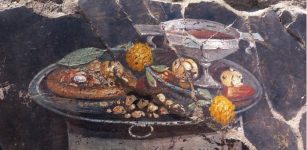 Ancestor Of Italian Pizza Depicted On Fresco In Pompeii
Archaeology | Jun 28, 2023
Ancestor Of Italian Pizza Depicted On Fresco In Pompeii
Archaeology | Jun 28, 2023 -
 Rare Medieval Tattoo Depicting A Christogram Unearthed In Ghazali, Sudan
Archaeology | Nov 9, 2023
Rare Medieval Tattoo Depicting A Christogram Unearthed In Ghazali, Sudan
Archaeology | Nov 9, 2023


